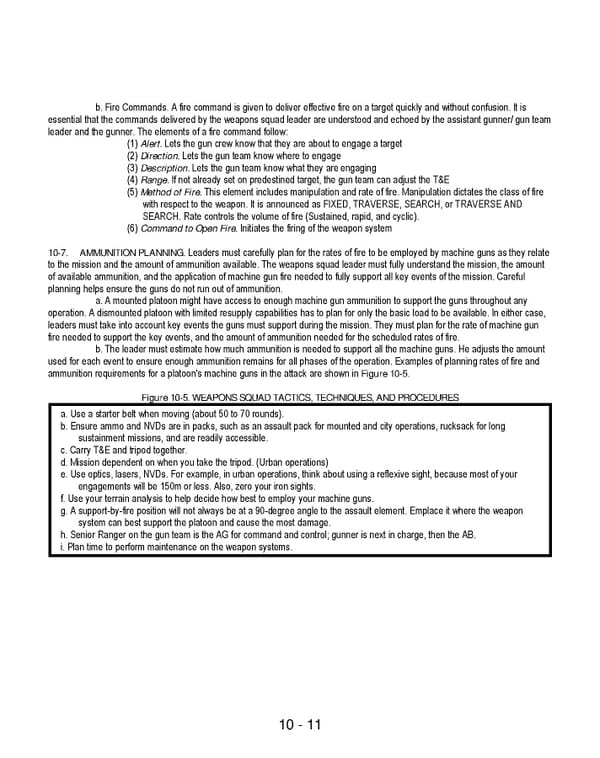10 - 11 b. Fire Commands. A fire command is given to deliver effective fire on a target quickly and without confusion. It is essential that the commands delivered by the weapons squad leader are understood and echoed by the assistant gunner/ gun team leader and the gunner. The elements of a fire command follow: (1) Alert. Lets the gun crew know that they are about to engage a target (2) Direction. Lets the gun team know where to engage (3) Description. Lets the gun team know what they are engaging (4) Range. If not already set on predestined target, the gun team can adjust the T&E (5) Method of Fire. This element includes manipulation and rate of fire. Manipulation dictates the class of fire with respect to the weapon. It is announced as FIXED, TRAVERSE, SEARCH, or TRAVERSE AND SEARCH. Rate controls the volume of fire (Sustained, rapid, and cyclic). (6) Command to Open Fire. Initiates the firing of the weapon system 10-7. AMMUNITION PLANNING. Leaders must carefully plan for the rates of fire to be employed by machine guns as they relate to the mission and the amount of ammunition available. The weapons squad leader must fully understand the mission, the amount of available ammunition, and the application of machine gun fire needed to fully support all key events of the mission. Careful planning helps ensure the guns do not run out of ammunition. a. A mounted platoon might have access to enough machine gun ammunition to support the guns throughout any operation. A dismounted platoon with limited resupply capabilities has to plan for only the basic load to be available. In either case, leaders must take into account key events the guns must support during the mission. They must plan for the rate of machine gun fire needed to support the key events, and the amount of ammunition needed for the scheduled rates of fire. b. The leader must estimate how much ammunition is needed to support all the machine guns. He adjusts the amount used for each event to ensure enough ammunition remains for all phases of the operation. Examples of planning rates of fire and ammunition requirements for a platoon's machine guns in the attack are shown in Figure 10-5. Figure 10-5. WEAPONS SQUAD TACTICS, TECHNIQUES, AND PROCEDURES a. Use a starter belt when moving (about 50 to 70 rounds). b. Ensure ammo and NVDs are in packs, such as an assault pack for mounted and city operations, rucksack for long sustainment missions, and are readily accessible. c. Carry T&E and tripod together. d. Mission dependent on when you take the tripod. (Urban operations) e. Use optics, lasers, NVDs. For example, in urban operations, think about using a reflexive sight, because most of your engagements will be 150m or less. Also, zero your iron sights. f. Use your terrain analysis to help decide how best to employ your machine guns. g. A support-by-fire position will not always be at a 90-degree angle to the assault element. Emplace it where the weapon system can best support the platoon and cause the most damage. h. Senior Ranger on the gun team is the AG for command and control; gunner is next in charge, then the AB. i. Plan time to perform maintenance on the weapon systems.
 Ranger Handbook Page 206 Page 208
Ranger Handbook Page 206 Page 208